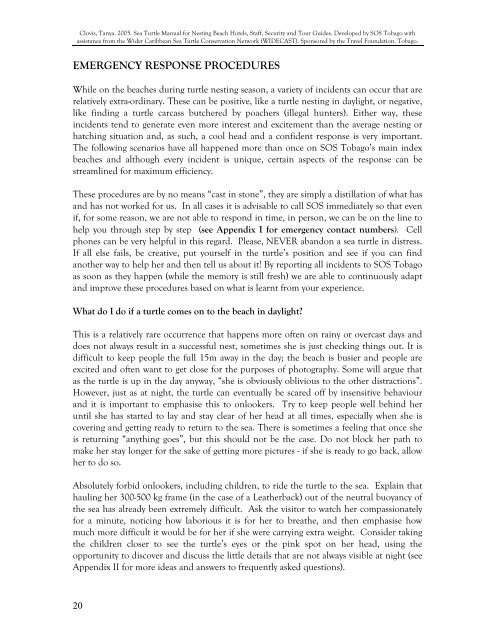Clovis, Tanya. - WIDECAST
Clovis, Tanya. - WIDECAST
Clovis, Tanya. - WIDECAST
Create successful ePaper yourself
Turn your PDF publications into a flip-book with our unique Google optimized e-Paper software.
<strong>Clovis</strong>, <strong>Tanya</strong>. 2005. Sea Turtle Manual for Nesting Beach Hotels, Staff, Security and Tour Guides. Developed by SOS Tobago with<br />
assistance from the Wider Caribbean Sea Turtle Conservation Network (<strong>WIDECAST</strong>). Sponsored by the Travel Foundation. Tobago.<br />
EMERGENCY RESPONSE PROCEDURES<br />
While on the beaches during turtle nesting season, a variety of incidents can occur that are<br />
relatively extra-ordinary. These can be positive, like a turtle nesting in daylight, or negative,<br />
like finding a turtle carcass butchered by poachers (illegal hunters). Either way, these<br />
incidents tend to generate even more interest and excitement than the average nesting or<br />
hatching situation and, as such, a cool head and a confident response is very important.<br />
The following scenarios have all happened more than once on SOS Tobago’s main index<br />
beaches and although every incident is unique, certain aspects of the response can be<br />
streamlined for maximum efficiency.<br />
These procedures are by no means “cast in stone”, they are simply a distillation of what has<br />
and has not worked for us. In all cases it is advisable to call SOS immediately so that even<br />
if, for some reason, we are not able to respond in time, in person, we can be on the line to<br />
help you through step by step (see Appendix I for emergency contact numbers). Cell<br />
phones can be very helpful in this regard. Please, NEVER abandon a sea turtle in distress.<br />
If all else fails, be creative, put yourself in the turtle’s position and see if you can find<br />
another way to help her and then tell us about it! By reporting all incidents to SOS Tobago<br />
as soon as they happen (while the memory is still fresh) we are able to continuously adapt<br />
and improve these procedures based on what is learnt from your experience.<br />
What do I do if a turtle comes on to the beach in daylight<br />
This is a relatively rare occurrence that happens more often on rainy or overcast days and<br />
does not always result in a successful nest, sometimes she is just checking things out. It is<br />
difficult to keep people the full 15m away in the day; the beach is busier and people are<br />
excited and often want to get close for the purposes of photography. Some will argue that<br />
as the turtle is up in the day anyway, “she is obviously oblivious to the other distractions”.<br />
However, just as at night, the turtle can eventually be scared off by insensitive behaviour<br />
and it is important to emphasise this to onlookers. Try to keep people well behind her<br />
until she has started to lay and stay clear of her head at all times, especially when she is<br />
covering and getting ready to return to the sea. There is sometimes a feeling that once she<br />
is returning “anything goes”, but this should not be the case. Do not block her path to<br />
make her stay longer for the sake of getting more pictures - if she is ready to go back, allow<br />
her to do so.<br />
Absolutely forbid onlookers, including children, to ride the turtle to the sea. Explain that<br />
hauling her 300-500 kg frame (in the case of a Leatherback) out of the neutral buoyancy of<br />
the sea has already been extremely difficult. Ask the visitor to watch her compassionately<br />
for a minute, noticing how laborious it is for her to breathe, and then emphasise how<br />
much more difficult it would be for her if she were carrying extra weight. Consider taking<br />
the children closer to see the turtle’s eyes or the pink spot on her head, using the<br />
opportunity to discover and discuss the little details that are not always visible at night (see<br />
Appendix II for more ideas and answers to frequently asked questions).<br />
20
















